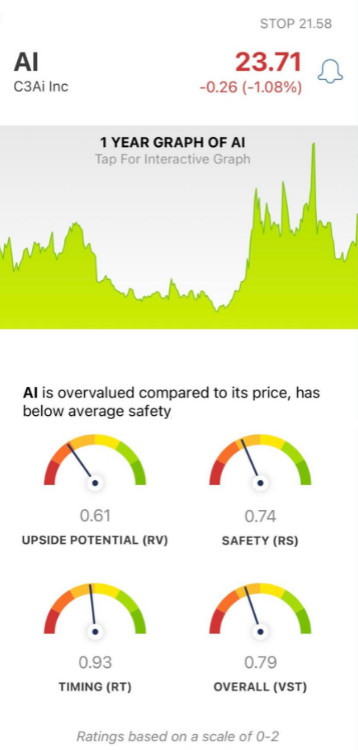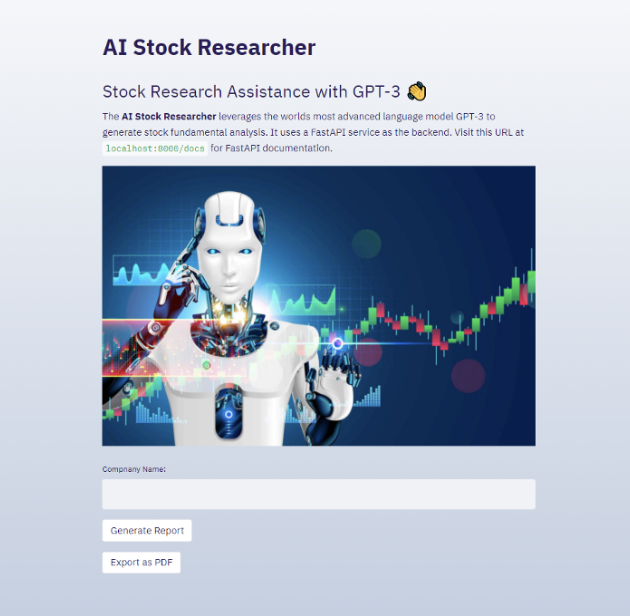20 New Facts For Choosing AI Stock {Investing|Trading|Prediction|Analysis) Sites
20 New Facts For Choosing AI Stock {Investing|Trading|Prediction|Analysis) Sites
Blog Article
Top 10 Tips To Evaluate The Ai And Machine Learning Models In Ai Stock Predicting/Analysing Trading Platforms
Analyzing the AI and machine learning (ML) models used by trading and stock prediction platforms is vital to ensure they deliver accurate, reliable, and actionable insights. Models that are poor-designed or over-hyped can lead to inaccurate forecasts and financial losses. Here are 10 best suggestions to assess the AI/ML capabilities of these platforms.
1. The model's approach and purpose
Clarified objective: Determine the model's purpose and determine if it's intended for trading on short notice, investing long term, sentimental analysis or a risk management strategy.
Algorithm transparency: See if the platform discloses the types of algorithms employed (e.g., regression, decision trees, neural networks, reinforcement learning).
Customizability. Find out whether the model is able to be tailored to your trading strategy or the level of risk tolerance.
2. Perform an analysis of the model's performance metrics
Accuracy Verify the accuracy of the model's prediction. Don't solely rely on this measure, however, as it may be misleading.
Precision and recall: Assess whether the model is able to detect true positives, e.g. correctly predicted price fluctuations.
Risk-adjusted return: Determine if the model's forecasts lead to profitable trades, after accounting for risks (e.g. Sharpe ratio, Sortino coefficient).
3. Test the model by Backtesting
Performance history The model is tested by using data from the past to assess its performance in prior market conditions.
Test the model on information that it hasn't been trained on. This will help stop overfitting.
Scenario analyses: Check the performance of your model under different markets (e.g. bull markets, bear markets, high volatility).
4. Be sure to check for any overfitting
Overfitting signs: Look for models that perform extremely good on training data but poorly on unseen data.
Regularization techniques: Verify whether the platform is using techniques such as L1/L2 regularization or dropout to prevent overfitting.
Cross-validation: Make sure the platform uses cross-validation to assess the model's generalizability.
5. Assess Feature Engineering
Relevant Features: Check to see whether the model is based on meaningful features. (e.g. volume, price, technical indicators and sentiment data).
Make sure to select features with care It should contain data that is statistically significant and not irrelevant or redundant ones.
Updates of dynamic features: Check if your model has been updated to reflect recent characteristics and current market conditions.
6. Evaluate Model Explainability
Interpretability - Ensure that the model offers an explanation (e.g. the SHAP values or the importance of a feature) to support its claims.
Black-box Models: Be cautious when platforms employ complex models that do not have explanation tools (e.g. Deep Neural Networks).
The platform should provide user-friendly information: Make sure the platform provides actionable information which are presented in a manner that traders will understand.
7. Examine Model Adaptability
Changes in the market: Check if the model can adapt to changes in market conditions, like economic shifts or black swans.
Verify that your system is updating its model regularly by adding new data. This can improve performance.
Feedback loops: Ensure that the platform incorporates feedback from users or actual results to improve the model.
8. Be sure to look for Bias or Fairness.
Data biases: Check that the training data are representative and free from biases.
Model bias: Find out if you are able to actively detect and reduce biases that exist in the predictions of the model.
Fairness: Make sure the model doesn't disadvantage or favor certain stocks, sectors or trading strategies.
9. Evaluation of the computational efficiency of computation
Speed: Evaluate whether you can predict with the model in real-time.
Scalability Verify the platform's ability to handle large amounts of data and multiple users with no performance loss.
Utilization of resources: Ensure that the model has been designed to make optimal use of computational resources (e.g. GPU/TPU use).
10. Transparency in Review and Accountability
Model documentation - Make sure that the platform has detailed information about the model, including its design, structure the training process, its the limitations.
Third-party Audits: Check whether the model was independently audited or validated by third organizations.
Check that the platform is fitted with mechanisms to detect model errors or failures.
Bonus Tips
Reviews of users and Case studies Review feedback from users and case studies in order to determine the real-world performance.
Free trial period: Test the model's accuracy and predictability by using a demo or a free trial.
Customer support: Make sure that your platform has a robust support for technical or model-related issues.
By following these tips you can examine the AI/ML models on stock prediction platforms and make sure that they are reliable as well as transparent and linked to your trading goals. View the recommended more tips here about copyright ai trading bot for site recommendations including ai stocks, investing ai, best ai for trading, ai chart analysis, ai invest, best ai trading app, stock ai, ai trade, incite, best stock advisor and more.
Top 10 Tips To Assess The Risk Management Aspect Of Ai Stock-Predicting/Analyzing Platforms
A trading platform that uses AI to forecast or analyze stocks must have a robust risk management process. This can protect your capital, and help minimize any potential losses. Platforms that have robust risk management capabilities will help you navigate the market volatility and make an informed decision. Here are ten tips to help you assess the risk management capabilities of these platforms.
1. Examine Stop-Loss features and Take Profit features
Customizable settings: Make sure you set your maximum take-profit and stop-loss levels for a specific trade.
Check whether the platform allows for trailing stops. They will automatically adjust themselves as markets shift in your direction.
If the platform provides the option of a stop-loss order that guarantees the position will be closed to the amount specified in markets that are volatile and you are assured of a profitable trade.
2. Assessment Position Sizing Tools
Fixed amount. You should can define your position sizes by the fixed dollar amount.
Percentage of Portfolio Find out whether it is feasible to set the position size in percentage of your portfolio total to control risk in a proportional way.
Risk-reward: Make sure your platform lets you determine risk-rewards for each trade or strategy.
3. Make sure you are using Diversification Aid
Multi-asset trade: Make sure that your platform can handle trading across different types of assets (e.g. stocks, ETFs, options, forex) to diversify your portfolio.
Sector allocation Check to find out if there are tools available for managing and monitoring sector exposure.
Geographic diversification. Make sure the platform can trade internationally and spread geographic risk.
4. Assess margin and leverage control
Margin requirements: Ensure the platform clearly outlines the margin requirements for leveraged trading.
Examine the platform to determine whether it lets you set limits on leverage to lower risk.
Margin call - Check to see if your platform alerts you to margin calls in a timely manner. This can help avoid liquidation.
5. Assessment of Risk Analytics and Reporting
Risk metrics - Make sure that your platform has important risk indicators like the Sharpe ratio (or Value at Risk (VaR)) or drawdown (or value of the portfolio).
Scenario evaluation: Make sure the platform you're using allows you to simulate market scenarios and evaluate risk.
Performance reports: Find out if you can get detailed reports on performance from the platform, which include the risk-adjusted outcomes.
6. Check for Real-Time Risk Monitoring
Portfolio monitoring - Make sure that the platform you select provides real-time monitoring so that your portfolio is secure.
Alerts and notifications. Verify whether the platform can provide real-time notification of risk-related events.
Look for dashboards with customizable options that provide a comprehensive overview of your risk profile.
7. Evaluation of Backtesting and Stress Testing
Stress testing - Ensure that your platform allows you stress test strategies and portfolios under extreme market situations.
Backtesting: Determine whether the platform allows backtesting strategies based on previous data to evaluate the risk and effectiveness.
Monte Carlo Simulations: Check if the platform utilizes Monte Carlo simulations in order to assess and model a range possible outcomes.
8. Risk Management Regulations Compliance Assessment
Compliance with regulatory requirements: Make sure the platform complies with relevant rules for risk management (e.g., MiFID II in Europe, Reg T in the U.S.).
Best execution: Ensure that the platform follows best execution practices. This will ensure that trades are executed according to the highest price possible in order to reduce slippage.
Transparency. Make sure the platform is transparent and provides clear disclosures about potential risks.
9. Examine for Risks that are User Controlled Parameters
Custom risk rules: Make sure the platform you choose permits you to develop unique risk management guidelines.
Automated risks controls: Verify whether the platform is able to automatically enforce rules for risk management in accordance with the parameters you've set.
Manual overrides Check for the possibility of manually overriding the risk management system in the event of an emergency.
Review Case Studies and User Feedback
User reviews: Review user feedback to determine the effectiveness of the platform's risk management.
Case studies: Search for case studies or testimonials that highlight the platform's capabilities in risk management.
Community forums: Check whether the platform has an active user community where traders can share tips for managing risk and strategies.
Bonus Tips
Trial period: Make use of a free demo or trial to test the platform’s risk management capabilities in realistic scenarios.
Support for customers: Ensure that the platform can provide robust support in relation to questions or concerns relating to the management of risk.
Educational resources: Find out whether your platform has instructional materials or tutorials which explain risk management strategies.
If you follow these guidelines, you can determine the capabilities of AI platforms for stock prediction and analysis to manage risk. This will ensure you select a system that protects your investment and reduces any losses that could occur. To make trading successful and navigate volatile markets, robust risk management tools are crucial. Check out the most popular stocks ai for blog examples including ai for investing, ai investing app, stock analysis websites, chart analysis ai, ai chart analysis, ai stock picks, copyright financial advisor, trader ai review, ai trading app, trading with ai and more.